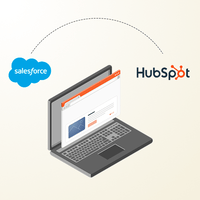HubSpot Implementation
STREAMLINE YOUR SALES AND MARKETING EFFORTS: HUBSPOT AND SALESFORCE INTEGRATION
Posted By On the fuze, Jul 24, 2023 11:02:29 PM

Stay updated on all things HubSpot automation, website development and design by following our blog posts.
When it comes to sales and marketing, two of the most powerful tools on the market are HubSpot and Salesforce.
Individually, these platforms have great functionality. However, many companies choose to ues both systems to take advantage of each tools strengths!
In this blog, we'll explore the benefits and possibilities of integrating HubSpot and Salesforce, helping you leverage the platforms for your business goals.
Why Integrate HubSpot and Salesforce?
The integration between HubSpot and Salesforce allows seamless data syncing and improved collaboration between your sales and marketing teams.
By integrating these two platforms, you'll be able to:
- Eliminate data silos: Say goodbye to manual data entry and the frustration of inconsistent information across different systems. With this integration, ensure data is accurate and updated in real-time.
- Achieve holistic lead management: The integration enables you to track and manage leads from initial contact to closed deals, providing a holistic view of your sales pipeline. This helps align both team’s efforts and make data-driven decisions.
- Enhance lead nurturing and segmentation: By combining the powerful marketing automation capabilities of HubSpot with the robust CRM functionalities of Salesforce, you can create targeted campaigns and personalized experiences for your leads.
Key Features and Benefits of the Integration:
1. Bi-directional Data Sync: The integration ensures that contact, lead, and opportunity data is seamlessly synchronized between HubSpot and Salesforce.
This means any changes made in one system will automatically update in the other, eliminating the need for manual updates and ensuring data accuracy.

2. Closed-Loop Reporting:
With integration, you can track and measure the impact of your marketing efforts on sales revenue.
By attributing closed deals to specific marketing activities, you gain valuable insights into which campaigns drive the most revenue, allowing you to optimize your marketing strategy.
3. Sales Enablement: Sales reps can access valuable marketing data, such as lead scoring, engagement history, and email interactions, directly within Salesforce.
This empowers them with the right information at the right time, enabling more personalized and effective sales conversations.
How to Get Started?
Integrating HubSpot and Salesforce is a straightforward process. Here's a general overview of the native integration:
- Ensure your HubSpot and Salesforce accounts are set up properly.
- Install the integration.
- Map your contact, lead, and opportunity fields between the two platforms.
- Test the integration and ensure that data is syncing correctly.
- Train your sales and marketing teams on how to leverage the integrated features.
Maybe do you need to do to resolve field mapping errors? To resolve easy field mapping errors, take action on any indicated issues or warnings. Check more info here.
By integrating HubSpot and Salesforce, empowers your teams to work smarter and more efficiently. So, whether you're a small business or a large enterprise, consider harnessing the power of integration to take your sales and marketing game to the next level.
Download our HubSpot to Salesforce Integration Plan to ensure success!
If you're looking for HubSpot Experts to ensure you’re getting the most efficiency out of the tool, contact us to learn more.
HubSpot to Salesforce Integration Plan
Get our downloadable FREE planner that you can apply to improve your Integration process.
Related Post

